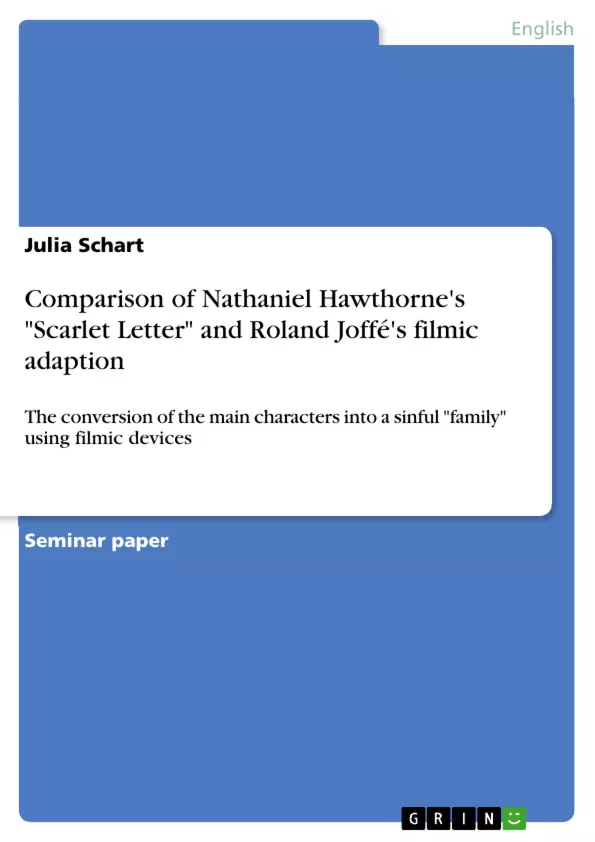I have chosen to examine one of the latest filmic adaptions of "The Scarlet Letter", made by Roland Joffé and the main distinctions to Hawthorne's version. If you delve deeper into the matter, you recognize that the Hollywood director has placed various personal focuses on different parts of the novel, especially on the most important protagonists.
Furthermore, in large parts he totally rolled up the gist and used different perspectives on certain things. That is why it can be called an extremely free conversion of Hawthorne's historical fiction into a love story with a dramatically romantic background. By using several filmic devices, he finally attempted to turn the three strong main characters into a sinful but "happy family" who are in search of a peaceful life.
The book "The Scarlet Letter" is one of America's most important pieces of literature, written by the author Nathaniel Hawthorne in the year 1850. The story about Puritan life and the subject of settling down in a "new world" has engaged the interest of numerous generations of readers up to now.
However, Hawthorne's classical work has not only caught the attention of normal literature lovers but it has also inspired a lot of artists, like producers and directors to convert the historical content into motion-pictures. What comes out in the end is often very surprising; for some critics the result is more positive, for others it is rather negative and unsatisfactory material. In this case, it always depends on what expectations you have of such a medial remake. Do you intend to get delivered a complete one-to-one transformation or are you open-minded enough to accept a creative and free modification of the original basic script? This could be sometimes a highly controversial question among reviewers.
Table of Contents
- Introduction
- Roland Joffé and his work
- The Structure of the story
- Hawthorne's setup
- Joffé's setup
- Historical fiction versus romance
- The three main characters
- Pearl Prynne
- Arthur Dimmesdale
- Hester Prynne
- The idea of a sinful but “happy family”
- Conclusion
Objectives and Key Themes
This essay analyzes Roland Joffé's film adaptation of Nathaniel Hawthorne's "The Scarlet Letter", focusing on the differences between the original novel and the film. It examines Joffé's choices in adapting the characters, themes, and overall narrative, particularly his transformation of the characters into a "sinful but happy family" within a romantic setting.
- The differences in structure between the novel and the film
- The portrayal of historical fiction versus romance in both works
- The transformation of the characters and their relationships
- The use of filmic devices to create a romantic atmosphere
- The interpretation of adultery and sin in Puritan society
Chapter Summaries
The introduction discusses the enduring popularity of "The Scarlet Letter" and the challenges of adapting such a classic work to film. The essay then introduces Roland Joffé, the director of the film adaptation, and highlights his previous work and the critical reception of his adaptation of "The Scarlet Letter".
The chapter on the structure of the story delves into the differences in how both Hawthorne and Joffé present the narrative. It analyzes Hawthorne's use of a first-person narrator and the gradual introduction of the central plot, contrasting it with Joffé's more direct approach.
Further chapters explore the interpretation of historical fiction versus romance in both works, and examine the portrayal of the three main characters – Hester, Arthur, and Pearl – in both the novel and the film. Particular attention is paid to the development of the characters and the changes made by Joffé in their relationships.
Keywords
Key keywords and concepts explored in this essay include: "The Scarlet Letter", Nathaniel Hawthorne, Roland Joffé, film adaptation, historical fiction, romance, adultery, sin, Puritan society, character transformation, filmic devices, and "happy family".
- Citar trabajo
- Julia Schart (Autor), 2010, Comparison of Nathaniel Hawthorne's "Scarlet Letter" and Roland Joffé's filmic adaption, Múnich, GRIN Verlag, https://www.grin.com/document/503419



